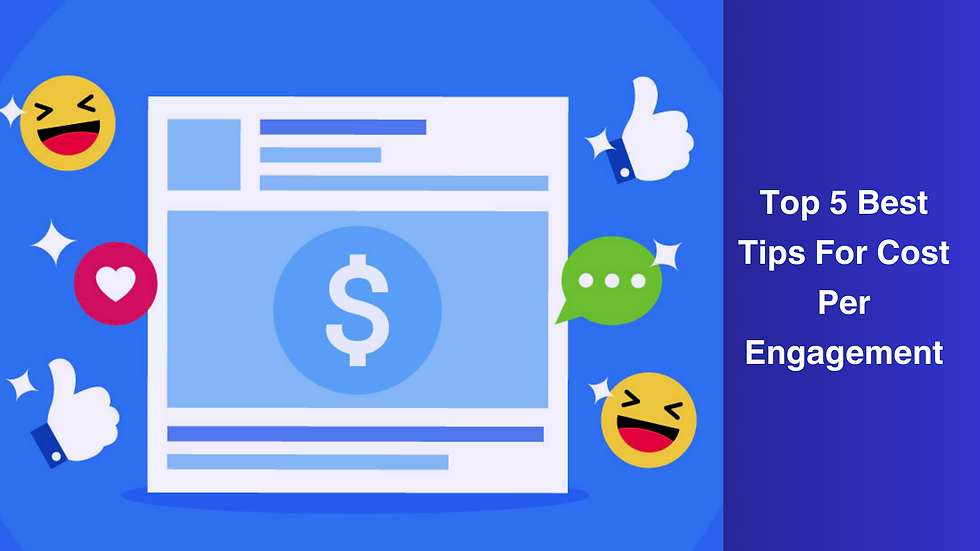Top 5 Best Tips For Impressions Into Conversions With Cost Per Engagement
- cathijohnson889
- Sep 29, 2023
- 3 min read
Businesses in today's digital age compete for attention in an increasingly crowded online marketplace. Impressions, the number of times your content is displayed, are essential for creating brand awareness and attracting potential customers. However, it's not enough to effortlessly generate impressions; the real challenge lies in converting those impressions into meaningful interactions and, ultimately, sales.
It is where Cost Per Engagement (CPE) comes into play. CPE is a crucial metric that measures the cost incurred for each user engagement, such as clicks, likes, shares, or comments. To maximize the return on investment (ROI) from your marketing efforts, here are the top 5 best tips for turning impressions into conversions with CPE.
Target the Right Audience
One of the most common mistakes businesses make is casting too wide a net when trying to generate impressions. While receiving a lot of impressions may seem impressive, reaching the right audience is far more valuable. Targeting the right demographic ensures that your content is seen by people who are genuinely interested in your products or services. To achieve this, use advanced targeting options provided by social media platforms and online advertising tools. Segment your audience based on factors such as age, gender, location, interests, and behavior. Your chances of engaging potential customers who are more likely to convert increase with more precise targeting.
Create Compelling and Relevant Content
Impressions are just the first step in the conversion journey. To turn those impressions into engagement-oriented details and, ultimately, conversions, you need to create content that captures the audience's attention and resonates with their needs and desires. Your writing should be captivating, instructive, and appealing to the eye. It should provide value to the audience and address their pain points. Use high-quality images and videos, craft compelling headlines, and ensure your messaging is clear and concise. A well-designed landing page or website that follows best practices for user experience can also significantly impact conversion rates. Remember, the more engaging and relevant your content is, the lower your CPE will likely be.
Optimize Ad Formats and Placement
Different ad formats and placements can yield varying levels of engagement and conversion rates. Experiment with various ad formats, such as image ads, video ads, carousel ads, and sponsored posts, to see which ones resonate best with your audience. Additionally, consider where your ads are displayed. Placing ads on platforms and websites that your target audience frequents can increase the chances of engagement. Native advertising, where ads seamlessly blend with the content on a platform, often performs well in terms of CPE because it appears less intrusive to users. Continuously monitor the performance of your ads and make adjustments as needed to optimize CPE.
Implement Retargeting Campaigns
A significant percentage of your website visitors and social media followers may not convert on their first interaction with your brand. Retargeting campaigns are functional in this situation. Retargeting involves showing ads to users who have previously engaged with your content or visited your website. These Facebook marketing ads serve as gentle reminders and encourage users to return and complete a desired action, such as making a purchase or filling out a contact form. Retargeting campaigns often have lower CPE because they target users who have already shown an interest in your products or services. By staying top-of-mind and providing relevant offers, conversions will increase.
Use A/B Testing
A/B testing, also known as split testing, is a powerful tool for improving your CPE. It involves creating two or more versions of an ad or landing page and showing them to different segments of your audience to determine which one performs better. By analyzing the results, you can identify what elements of your content, design, or messaging generate the most interest and conversions. This data-driven approach allows you to make informed decisions and refine your marketing strategy over time. Experiment with different call-to-action (CTA) buttons, ad copy, images, and headlines to see which combinations generate the lowest CPE and the highest conversion rates.
Also Watch: How To Create User Request For A New Advertisement - How to Tutorial Series | PowerAdSpy
Epilogue!!
Turning impressions into conversions with a low Cost Per Engagement (CPE) is the main objective for businesses in the digital age. For this to happen, you must target the right audience, create compelling and relevant content, optimize ad formats and placements, use A/B testing to refine your strategy, and implement retargeting campaigns. By following these top 5 tips, you can not only reduce your CPE but also maximize your overall ROI and drive meaningful results for your business. Remember that digital marketing is a dynamic field, so staying updated with the latest trends and technologies is crucial for long-term success in converting impressions into conversions.



Comments